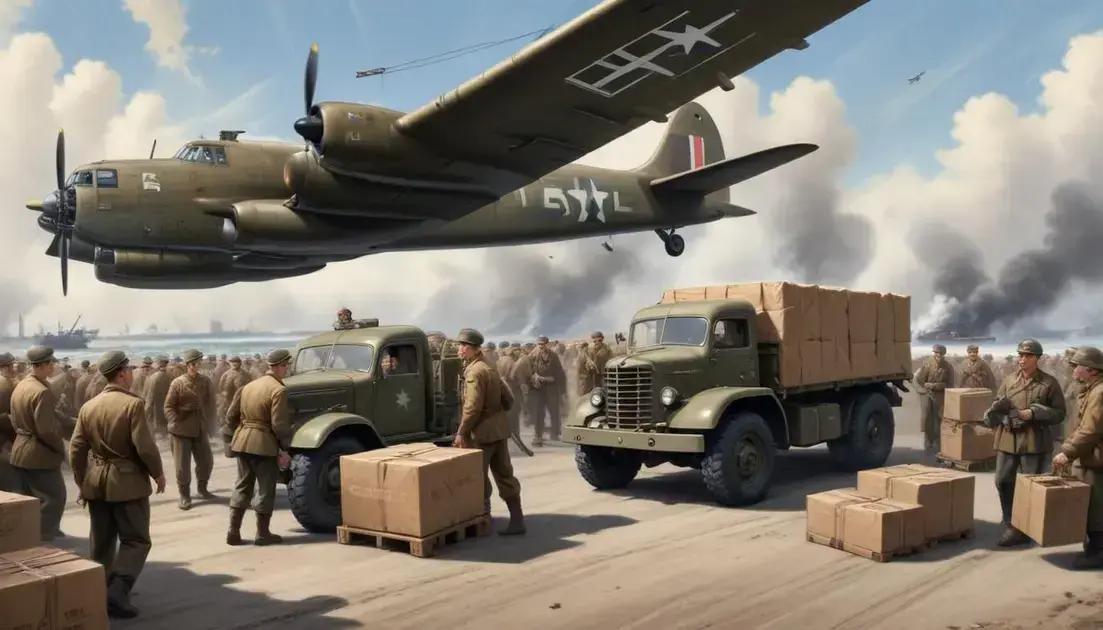
Lend-Lease Program: How the USA Financed the Allies in WWII
The Lend-Lease Program was a crucial initiative by the U.S. during World War II that provided vital supplies, including weapons, food, and vehicles, to Allied nations. This support strengthened military capabilities and fostered international relationships while also sparking debates about its economic and political implications. The program highlighted the importance of cooperation among nations in times of crisis, leaving a lasting impact on wartime strategies and diplomatic ties.
Before officially entering WWII, the Lend-Lease program was critical in supporting Allied nations. Curious about its impact? Let’s dive in!
Introduction to the Lend-Lease Program
The Lend-Lease Program began in 1941. It was a way for the United States to help its allies during World War II. This program provided vital supplies like food, weapons, and vehicles. The idea was simple: help those fighting against the Axis powers, even before America joined the war.
Why Was It Important? The program was crucial because it helped nations like Britain and the Soviet Union get what they needed to continue their fight. By sending these supplies, the U.S. showed its support and commitment to win the war.
Many types of goods were shared, from tanks to aircraft and even raw materials. This aid gave the Allies strength and boosted their chances against their enemies.
Another key point was how the program worked. Nations could request items they needed, and the U.S. would provide them. This system of mutual help created stronger ties between countries.
The Lend-Lease Program was a game changer. It helped shape the outcome of the war. By providing support without direct involvement in battles, the U.S. played a significant role in military success.
Key Supplies Provided
The Lend-Lease Program provided many key supplies. These were crucial for the Allies in their fight. One major category was armaments, including rifles, tanks, and airplanes. These weapons helped strengthen the military forces of nations like Britain and the Soviet Union.
Food and Medical Supplies were also vital. The U.S. sent significant amounts of food, which ensured that soldiers and civilians had enough to eat. Medical supplies were important, too. They included bandages, medicine, and other necessities to treat the wounded.
Raw Materials like steel and aluminum were shipped to aid war production. These materials allowed factories to produce more vehicles and equipment quickly. The program made sure the Allies had what they needed to keep up the fight against the Axis powers.
Finally, vehicles were a critical part of this aid. Trucks and jeeps helped transport supplies and troops. The mobility provided by these vehicles made a big difference on the battlefield.
Impact on the Allies
The impact of the Lend-Lease Program on the Allies was enormous. This aid provided them with essential resources during World War II. With military supplies, they could strengthen their defenses and push back against enemy forces.
Strengthened Military Capabilities: The weapons and vehicles boosted the combat abilities of nations like Britain and the Soviet Union. They could fight more effectively and hold their ground against the Axis powers.
Economic Support: The supplies also helped stabilize economies. By receiving food and materials, countries could support their own civilians while focusing on the war effort. This kept morale high and ensured people had what they needed.
Building Alliances: The program cemented political ties between the United States and Allied nations. It showcased a spirit of cooperation, encouraging countries to work together against a common enemy.
The Lend-Lease Program transformed the capacity of the Allies. It allowed them to not only survive but thrive in an uncertain world.
Controversies and Perspectives
The Lend-Lease Program sparked many controversies during its operation. Some people questioned whether the U.S. should support foreign nations while staying out of the war. Critics worried about the economic costs. They felt resources could be better used at home.
Military Risks: Others raised concerns about the risks involved. By aiding Allies, the U.S. could be dragged into the conflict. Supporters argued that this help was vital for stopping the Axis powers.
Political Perspectives: Politicians had varied views on the program. Some saw it as a necessary measure to protect democracy. Others believed it might lead to deeper involvement in the war.
The Lend-Lease Program also led to discussions about international aid. Should a country help others in need, even if it poses risks to itself? This question continues to generate debate today.
Ultimately, the mixed reactions illustrate the complexities of wartime decisions. The Lend-Lease Program was a bold move that reflected the values and priorities of its time.
Conclusion
The Lend-Lease Program played a key role in World War II. It helped shape the outcomes of battles and supported many Allied nations. Without this assistance, the war could have turned out very differently.
Lasting Impact: The aid provided through this program was not just about supplies. It built strong international relationships, making allies feel valued and supported. This cooperation laid the groundwork for future partnerships.
Historical Significance: Today, we can see the Lend-Lease Program as a bold step. It showed a willingness to help others. This act of kindness in a time of crisis remains an important example of solidarity.
As we remember this program, we recognize the power of support in crisis. The Lend-Lease Program is an example of how aid can turn the tide in difficult times.
Conclusion
In conclusion, the Lend-Lease Program was a pivotal part of World War II. It provided crucial support to the Allies and helped change the course of history. This program showed the strength of cooperation between nations, demonstrating how much can be achieved when countries come together.
The aid given went beyond just supplies. It built lasting relationships and trust among nations. By supporting one another in tough times, countries can overcome great challenges. The spirit of the Lend-Lease Program reminds us today about the power of helping others.
As we reflect on this important chapter, we see that working together can lead to success. The lessons from the Lend-Lease Program continue to resonate, emphasizing the importance of unity and collaboration in the face of adversity.


